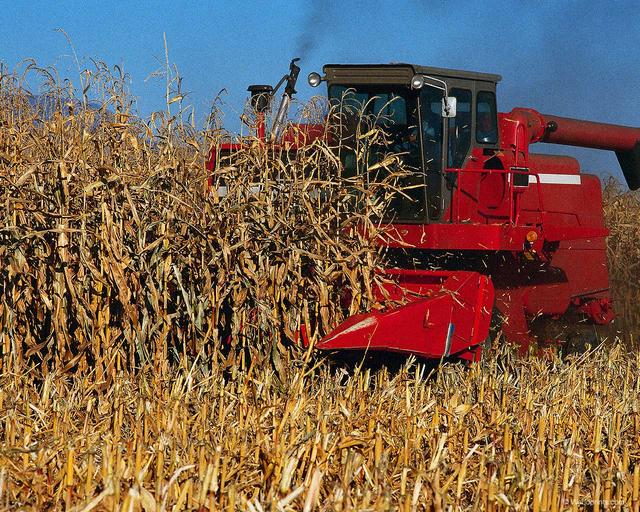
Agricultural News
Corn Prices are Falling- and It's Not Just Harvest Pressure
Tue, 15 Oct 2013 08:04:10 CDT
 Corn prices continue the long retreat from the peak of September 2012, declining to the lowest level since late August 2010. The most recent price weakness reflects both supply and demand considerations.
Corn prices continue the long retreat from the peak of September 2012, declining to the lowest level since late August 2010. The most recent price weakness reflects both supply and demand considerations.
On the supply side, ongoing reports of yields that exceed expectations in many areas suggest that the next USDA forecast of the U.S. average yield will be at least equal and perhaps exceed the September forecast of 155.3 bushels. There is still some uncertainty about the magnitude of harvested acreage that will not be cleared up, at least partially, until the USDA releases the next Crop Production report. Even so, it appears that production will be large enough to result in a sizable build-up in stocks by the end of the current marketing year.
On the demand side, the partial shutdown of federal government activities leaves a void in the usual flow of weekly data including export sales, export inspections, livestock slaughter, and broiler chick placements. The U.S. Energy Information Administration has also discontinued weekly estimates of ethanol production, imports, and stocks. The primary news on the demand side has been the leaked report of an apparent EPA proposal to reduce the magnitude of biofuels mandates, including renewable (ethanol) mandates, under the RFS beginning in calendar year 2014. The RFS currently calls for a total of 18.15 billion gallons of renewable fuels in 2014, including 3.75 billion gallons of advanced biofuels. The remaining 14.4 billion gallons can be satisfied with either advanced or renewable biofuels. The rumored proposal for 2014 is for a total of 15.21 billion gallons of biofuels, including only 2.21 billion gallons of advanced biofuels and a maximum of 13 billion gallons of renewable biofuels. The possibility of dropping the overall mandate by almost three billion gallons was not widely anticipated. The reduction in the non-advanced component of the mandate from 14.4 to13 billion gallons has been interpreted as a negative development for corn demand in 2014 and beyond.
The EPA has stated that proposed changes for the RFS in 2014 have not been finalized. In addition, the final proposal will be submitted for public comment so that changes in the proposal would be possible. It is therefore premature to assume that the rules in the leaked proposal will be the final rules for 2014. However, it is useful to analyze the potential impact on corn demand of a reduction in the implied mandate for renewable biofuels.
Domestic ethanol production has been relatively constant for the past four years, totaling 13.3 billion gallons in 2010, 13.9 billion in 2011, and 13.3 billion gallons in 2012. Production in 2013 will be within the range of the past three years. Ethanol production in 2014 will be influenced by a combination of the magnitude of the RFS mandate, the magnitude of the domestic blend wall for ethanol, the extent of the use of RINs credits to meet the RFS mandate, the net trade balance for ethanol, and the magnitude of discretionary blending of ethanol, if any. Domestic consumption of ethanol was near 12.9 billion gallons in 2010, 2011, and 2012. Consumption during the first seven months of 2013 was about 100 million gallons larger than during the same period last year. With some expansion in E85 consumption, it appears that the domestic blend wall is expanding slowly and may be as large as 13.2 billion gallons in 2014. An RFS mandate at or below that level could then be met by physical blending in 2014 and would not require the use of RINs credits. Given policy uncertainties in the future, parties might choose to hold onto RINs and meet the RFS with physical blending, particularly if RINs prices continue to decline.
Depending on the final magnitude of the RFS mandates in 2014, discretionary ethanol blending would likely have to be in the form of higher blends, most likely E85 in the immediate future. The ability to expand E85 consumption would be influenced by blending economics of E85 and the rate of increase in infrastructure required for deploying E85. If the final rules resemble the leaked rules, ethanol RINs prices will be very low and blending economics for E85 will be determined primarily by the retail price of E10 and the price of ethanol. The price of ethanol is primarily determined by the price of corn. Based on our earlier analysis, the current retail price of E10 near $3.30 would require corn prices near $3.70 to make E85 competitive at the pump on an energy equivalent basis. Persistently low corn prices, then, could motivate an expansion in E85 infrastructure and discretionary blending of ethanol.
Finally, the trade balance for U.S. ethanol will be influenced by the RFS mandate for biodiesel and for total advanced biofuels and the relative economics of meeting the total mandate with Brazilian sugar cane and biodiesel. If the total advanced mandate is only marginally higher than the biodiesel mandate, as rumored, imports of Brazilian ethanol would not likely increase from the relatively low level of this year and the U.S would maintain a positive ethanol trade balance. The size of those imports is important since imported ethanol crowds out domestic ethanol under a blend wall scenario.
A possible reduction in the RFS mandate for renewable biofuels has generally been interpreted as a negative development for corn demand. However, a broader consideration of the potential impacts suggest that corn demand, and therefore prices, in 2014 might be largely unaffected by a reduction.
Click on the LISTEN BAR below to hear Dr. Good's thoughts on the latest news as he talks with Todd Gleason about the current feed grain outlook.
WebReadyTM Powered by WireReady® NSI
Top Agricultural News
More Headlines...



















